| |
September 2015
|
|

1. Rocket Team places first
by Caitlin Fischer ('18), Rocket Team outreach and publicity chair
The MIT Rocket Team placed first in the Basic category of the 2015 International Rocket Engineering Competition in June!
We launched our rocket for the Experimental Sounding Rocketry Association's competition in Green River, Utah, along with representatives from 36 other universities from seven countries. This was our first time participating in the competition. Our category required us to launch a rocket to 10,000ft, deploy a payload for a scientific mission of our own design, and provide deliverables throughout the year for judging and review.
We had been working on our rocket for the competition over the past year. We had initially been developing our own liquid rocket engine with an aerospike nozzle, but had to redesign our rocket at the end of IAP due to issues with engine testing. During spring semester, we redesigned our rocket to accommodate a solid propellant motor. We also designed a payload intended to demonstrate roll rate control after separating from the main body at apogee. Our first test launch ended with us having to entirely rebuild our rocket due to a recovery failure, but the team was glad that to see our second test launch end successfully before the end of spring semester.
Ultimately, our rocket reached an altitude of 9,690ft - extremely close to our goal. Our recovery efforts were successful, and our payload appeared to deploy successfully. The deliverable components of our project also fared well, receiving high marks from the judges.
We truly appreciate all of the support from the AeroAstro Department, our sponsors, faculty advisors, and mentors, without whom we would not have been able to develop our projects to the extent that we did. We're really excited to have performed well at IREC, and we're looking forward to learning more and developing more rocketry projects over the next year!
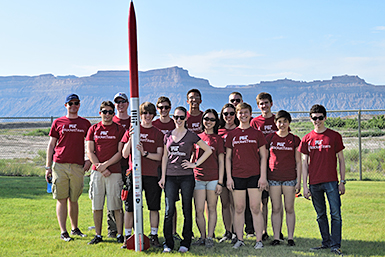
|

Each 16.30/31 student will be loaned a Parrot Rolling Spider minidrone
|

2. Class act
Students interested in commercial opportunities for unmanned aircraft systems may wish to learn more about this fall's course 16.866 Air Transportation System Architecture. Professor John Hansman, who teaches the course, says it will "focus on the conceptual phase of system definition, including technical, economic, market, environmental, regulatory, legal, manufacturing, and societal factors. Some core elements of systems engineering are also covered. Students will identify opportunities (vehicle, product or service) considering the technical, regulatory and market factors. Student teams will develop a business plans to exploit these opportunities and then create a conceptual design of the UAS system from the requirements which flow from that plan." For more info, email Professor Hansman at rjhans@mit.edu.
How do drones fly? Enroll in 16.30/16.31 Feedback Control Systems to learn how to design state-of-the-art estimation and control algorithms, and experiment with your own drone. Every student enrolled in 16.30/16.31 will be loaned a Parrot palm-size drone. Lab exercises will include the design of estimation and control algorithms for the minidrone. Students will be able to use our Matlab/Simulink tools to design, simulate, and generate embedded code for feedback control systems directly from the Matlab/Simulink environment. After the experiments, the data will be viewed in Matlab. No knowledge of programming or Matlab/Simulink is required. The class will be taught by AeroAstro Professor Sertac Karaman and MechE grad student Fabian Riether. For further info, come to the first lecture, Sept 9, 11am in room 33-419 or visit http://karaman.mit.edu/1630/
Professors Brian Wardle, Nick Roy, and Sheila Widnall want undergrads to know that you can do a very cool aerospace project in 16.62x Experimental Projects. First and foremost, while you'll be working closely with a faculty advisor, it'll be your research project. You choose the topic and advisor. Your responsibility is to define an experimental problem, develop a hypothesis, create objective statement(s) and success criteria consistent with the definition of the problem, identify experimental goals, design and construct the apparatus needed to perform the research, conduct the appropriate testing, evaluate the results, and propose relevant conclusions. You choose the topic and advisor. Your responsibility is to define an experimental problem, develop a hypothesis, create objective statement(s) and success criteria consistent with the definition of the problem, identify experimental goals, design and construct the apparatus needed to perform the research, conduct the appropriate testing, evaluate the results, and propose relevant conclusions. Contact Professors Wardle, Roy, or Widnall for more information.
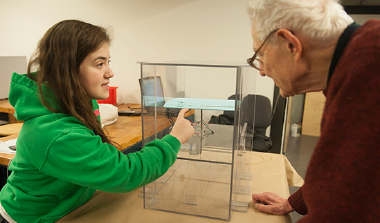
Undergrad
Ana Vazquez explains her team's wing with integrated bioinspired microelectromechanical sensors to Professor Emeritus John Dugundji during a 16.62x project display.
|
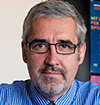
Peraire

Epstein

Ericsson
|

3. Awards, honors
Professor Jaime Peraire has received the Catalan Civil Engineers Association's Ildefons Cerdá Medal for “his exceptional international academic, scientific and professional career.”
The American Society of Mechanical Engineering awarded Professor Emeritus and Pratt & Whitney Vice President Alan Epstein its Aircraft Engine Technology Award. Epstein was nominated "for his exceptional contributions to aircraft engine technology, including techniques for innovative turbo-machinery experimentation methods, invention of the 'micro-engine' concept, creation and demonstration of active control of compressor instability and technology strategy development and implementation for a major aircraft engine manufacturer."
Alumna Aprilette Ericsson ('86), NASA Goddard Space Flight Center program manager, was selected one of Business Insider's 2015 "23 most powerful women engineers in the world."
Grad student Andrew Kennedy received Best Student Paper Award, Third Place at the 8th International Workshop on Satellite Constellations and Formation Flying. His paper was titled "On-Board Operations Scheduling Metrics for a Cooperative Earth Remote Sensing CubeSat Constellation."
Once more, US News and World Report has selected MIT AeroAstro as the nation's best undergraduate and graduate university engineering programs. Overall, the magazine ranked MIT as the seventh best US university.
|

Balakrishnan

Fischer

Stewart
|

4. Newsnotes
Professor Hamsa Balakrishnan has been promoted to Associate Professor with Tenure. In announcing the promotion, AeroAstro Department Head Jaime Peraire wrote, "Hamsa has demonstrated tremendous leadership and excellence as a researcher and educator. Hamsa is a scholar of optimization-based methods in control theory, and she has made important and lasting contributions to the introduction and use of new technologies in air traffic management."
NASA has announced it's selected USAF test pilot COL Jack Fischer (SM '98) for the May 2017 Space Station Expedition 52. It'll be Jack's first mission.
Alumnus Andrzej Stewart (MS '07) has been selected as a crew member for HI-SEAS Mission IV, a year-long Mars simulation conducted by the University of Hawaiʻi at Mānoa and funded by NASA.
KitCube, MIT's entry in the NASA Cube Quest Lunar Derby Challenge, is one of five winners in the competition. Cube Quest is a competition to build flight-qualified, small satellites capable of advanced communication and propulsion near and beyond the moon. KitCube is a 6U CubeSat designed by MIT 16.83 undergraduate and 16.89 graduate students designed for lunar orbit insertion, and high data rate burst transmission with max data throughput from lunar orbit. More than 40 students were involved in the project.
It's phishing season again at MIT as AeroAstro staff, students, and faculty report a recent increase in malicious emails. Some indicators that an email is likely phishing:
- Spelling errors and bad grammar
- Odd formatting (e.g., incorrect use of capital letters or punctuation)
- No real person's name included in either the greeting or signature of the email
- A return or reply-to email address that is not from mit.edu. You can view "full headers" to see what is listed as the actual return address.
- If a password is being requested, you know the email is not legitimate. No legitimate business will ever request your password. Look at what else is being requested as well (e.g., requesting your sex and country or territory should be a tip off that this would never come from MIT)
- A fake phone number, email or person listed as the contact information
- No mention of a phone number to call or person to contact
- Deleting an account due to lack of response or reaching a "quota": MIT doesn't do things like this to our community.
More info about phishing appears in MIT IS&T's Knowledge Base.
Reconstruction work on Building 31, home of the Gas Turbine Lab, is now in full swing. AeroAstro facilities manager Anthony Zolnik reports, "Mechanical, electrical, and plumbing investigations are ongoing, along with asbestos abatement and the installation of temporary fire suppression systems. Selective demolition is about to begin on the upper floors which will include the removal of all interior partitions and doors and door frames." Building 31 is undergoing a three-year, $47 million transformation into a state-of-the-art home for GTL, an autonomous systems research center, new offices for faculty and staff, and expansive workspaces for AeroAstro and Mechanical Engineering researchers and students. AeroAstro faculty and staff formerly residing in 31 have been relocated, primarily to Building 41. Temporary office assignments are: Courchesne-Sato - 41-205L, Greitzer - 41-205C, Letendre - 41-317B, Lettieri - 41-205F, Spakovszky - 41-205B, Toon -41-205L, Uranga - 41-205F. Professor Dave Darmofal is now in 33-219. For more on the project, see the article "Building 31 Renovations to Transform AeroAstro's Research Space" by Mark Veligor, which appears in the latest issue of AeroAstro, the department's annual magazine. |
|

5. In the picture

During her Navy ROTC training this summer, AeroAstro junior Faith Huynh met alumnus LT Andy Hill ('05, MS '07). Andy says, "I’ve been an ROTC instructor at USC since 2013, teaching ship engineering and weapons classes, and am also just about finished with a Master’s in Systems Architecting and Engineering from USC. This summer I was assigned as a staff officer at one of the summer training sessions that Navy ROTC students attend, known as CORTRAMID (Career ORientation TRAining for MIDshipmen). I was lucky enough to have the Midshipmen from the Boston NROTC Consortium, including MIT, in my 'company,'and happy to cross paths with a future AeroAstro graduate!"
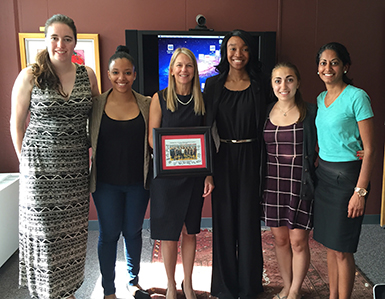
Following her May 15 swearing-in as NASA Deputy Director, Professor Dava Newman was presented with a photo signed by members of the MIT Women's Basketball Team. Head coach Sonia Raman says, "Professor Newman has been a mentor to our team for the past four years. She has talked to the team about leadership, academics, hosted them for dinners, and shared stories with the team from her own playing days at Notre Dame and her time coaching basketball at MIT while a grad student here. More than anything, she has inspired our group to reach new heights on and off the court." Pictured are (from left) Cathryn Hart, Zianga Abraham, Newman, Osheiza Otori, Liana Ilutzi and Raman.
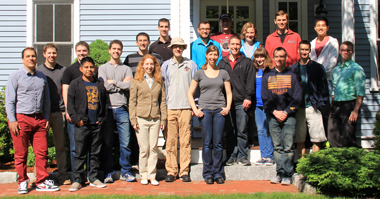
Space Systems Lab and STAR lab faculty, staff, and students gathered for their annual barbecue this summer.
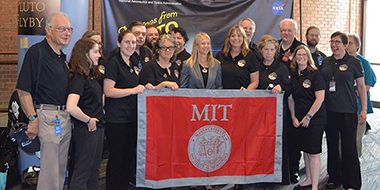 Thanks to Professor Rick Binzel for this picture of MITers celebrating at Johns Hopkins Applied Physics Lab during the New Horizons spacecraft Pluto fly-by in July: (from left) Larry Young, Amanda Zangari, Tiffany Finley, Alissa Earle, Mike Person, Andy Rivkin, Fran Bagenal, Amanda Bosh, Dava Newman, Cathy Olkin, Binzel, Bonnie Buratti, Ralph McNutt, Jillian Redfern, Steve Levine, Leslie Young, and Helen Hart. Thanks to Professor Rick Binzel for this picture of MITers celebrating at Johns Hopkins Applied Physics Lab during the New Horizons spacecraft Pluto fly-by in July: (from left) Larry Young, Amanda Zangari, Tiffany Finley, Alissa Earle, Mike Person, Andy Rivkin, Fran Bagenal, Amanda Bosh, Dava Newman, Cathy Olkin, Binzel, Bonnie Buratti, Ralph McNutt, Jillian Redfern, Steve Levine, Leslie Young, and Helen Hart.
|
|

6. Welcome
Welcome to visiting associate professor Ipek Basdogan; postdoc fellows Luiz Acauan and Markus Frey; and postdoc associates Sergio Amaral, Ulas Ayaz, Pooya Manzour Azadi, Daniele Bigoni, Fabio Caiazzo, Luca Carlone, Anirban Chaudhuri, Estelle Cohen, Carmen Guerra Garcia, Xun Huan, Alexandre Marques, Matthew Parno, Brendan Tracey, Philip Wolfe, and Carlos Netto Lahoz. Thanks to Anne Maynard for the list. |
 
|

Follow AeroAstro
Don't wait for your enews and emails — keep up with AeroAstro news as it happens — follow the department on Twitter and Facebook. |
|
If you know of events, honors, activities, or other information you'd like to see in the next issue of AeroAstro enews, please send to wlitant@mit.edu. |
|
|













 Thanks to Professor Rick Binzel for this picture of MITers celebrating at Johns Hopkins Applied Physics Lab during the New Horizons spacecraft Pluto fly-by in July: (from left) Larry Young, Amanda Zangari, Tiffany Finley, Alissa Earle, Mike Person, Andy Rivkin, Fran Bagenal, Amanda Bosh, Dava Newman, Cathy Olkin, Binzel, Bonnie Buratti, Ralph McNutt, Jillian Redfern, Steve Levine, Leslie Young, and Helen Hart.
Thanks to Professor Rick Binzel for this picture of MITers celebrating at Johns Hopkins Applied Physics Lab during the New Horizons spacecraft Pluto fly-by in July: (from left) Larry Young, Amanda Zangari, Tiffany Finley, Alissa Earle, Mike Person, Andy Rivkin, Fran Bagenal, Amanda Bosh, Dava Newman, Cathy Olkin, Binzel, Bonnie Buratti, Ralph McNutt, Jillian Redfern, Steve Levine, Leslie Young, and Helen Hart.